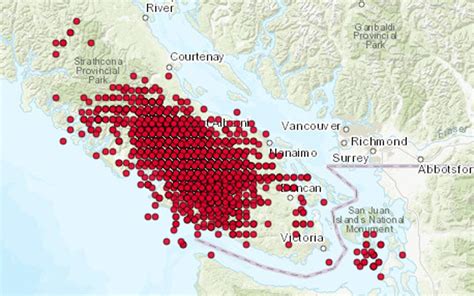Sunshine Coast Tremors: 5.1 Magnitude Earthquake Shakes Vancouver Island
The Sunshine Coast recently experienced a significant seismic event, a 5.1 magnitude earthquake that sent tremors throughout Vancouver Island and beyond. This event serves as a potent reminder of the region's seismic activity and the importance of preparedness. While thankfully no major damage or injuries were reported, the earthquake sparked considerable discussion about earthquake safety and the potential for future events.
Understanding the Earthquake
The earthquake, which struck on [Insert Date of Earthquake Here], originated near [Insert Location of Epicenter Here] on the Sunshine Coast. Its 5.1 magnitude was strong enough to be felt widely across Vancouver Island, with many reporting shaking and swaying. The depth of the earthquake [Insert Depth if available], further influencing the intensity felt in different locations.
Key takeaways from this event:
- Magnitude: A 5.1 magnitude earthquake is considered moderate and capable of causing damage in populated areas, especially to older or poorly constructed buildings.
- Location: The proximity to the Sunshine Coast and Vancouver Island underscores the region's vulnerability to earthquakes.
- Impact: While the lack of widespread damage is positive, it highlights the need for ongoing earthquake preparedness.
Seismic Activity on the West Coast
The West Coast of Canada, including British Columbia, sits on the Pacific Ring of Fire, a highly active seismic zone. This means earthquakes are a regular occurrence, although the intensity and frequency vary. Understanding this geological context is crucial for residents to prepare for potential future events.
Understanding Seismic Zones:
- Ring of Fire: Located on the Ring of Fire, British Columbia is prone to earthquakes of varying magnitudes.
- Fault Lines: Numerous fault lines crisscross the region, contributing to seismic activity.
- Historical Data: Studying historical earthquake data provides valuable insight into the frequency and intensity of past events.
Earthquake Preparedness: A Crucial Step
In the wake of the Sunshine Coast tremors, it's more important than ever to emphasize the need for preparedness. Knowing what to do before, during, and after an earthquake can significantly impact safety and well-being.
Essential Preparedness Steps:
- Emergency Kit: Assemble a comprehensive emergency kit including water, non-perishable food, first-aid supplies, a flashlight, radio, and extra batteries.
- Emergency Plan: Develop a family communication plan and ensure everyone knows what to do in the event of an earthquake. Designate a meeting point.
- Home Safety: Secure heavy items and appliances that could fall during an earthquake. Identify potential hazards in your home.
- Structural Assessment: For older buildings, consider a structural assessment to determine its earthquake resistance.
Learning from the Sunshine Coast Earthquake
The recent earthquake serves as a valuable learning experience. While the impact was relatively minimal, it underscores the importance of constant vigilance and preparedness. By taking proactive measures, communities can better mitigate the risks associated with seismic activity. Remember, preparation is key to safeguarding lives and property during and after an earthquake.
Keywords: Sunshine Coast earthquake, Vancouver Island earthquake, 5.1 magnitude earthquake, earthquake preparedness, seismic activity, British Columbia earthquake, earthquake safety, Ring of Fire, West Coast earthquakes, emergency preparedness, earthquake response.
